[English] 日本語
 Yorodumi
Yorodumi- PDB-5j13: Structural basis for TSLP antagonism by the therapeutic antibody ... -
+ Open data
Open data
- Basic information
Basic information
| Entry | Database: PDB / ID: 5j13 | ||||||
|---|---|---|---|---|---|---|---|
| Title | Structural basis for TSLP antagonism by the therapeutic antibody Tezepelumab (MEDI9929 / AMG-157) | ||||||
 Components Components |
| ||||||
 Keywords Keywords | IMMUNE SYSTEM / cytokine inflammation TSLP antibody | ||||||
| Function / homology |  Function and homology information Function and homology informationpositive regulation of chemokine (C-C motif) ligand 1 production / interleukin-7 receptor binding / positive regulation of granulocyte colony-stimulating factor production / positive regulation of mast cell activation / positive regulation of cytokine-mediated signaling pathway / positive regulation of receptor signaling pathway via STAT / interleukin-7-mediated signaling pathway / positive regulation of interleukin-13 production / positive regulation of interleukin-5 production / positive regulation of interleukin-10 production ...positive regulation of chemokine (C-C motif) ligand 1 production / interleukin-7 receptor binding / positive regulation of granulocyte colony-stimulating factor production / positive regulation of mast cell activation / positive regulation of cytokine-mediated signaling pathway / positive regulation of receptor signaling pathway via STAT / interleukin-7-mediated signaling pathway / positive regulation of interleukin-13 production / positive regulation of interleukin-5 production / positive regulation of interleukin-10 production / cell surface receptor signaling pathway via JAK-STAT / defense response to fungus / positive regulation of chemokine production / Interleukin-7 signaling / cytokine activity / positive regulation of interleukin-6 production / cytokine-mediated signaling pathway / positive regulation of inflammatory response / antimicrobial humoral immune response mediated by antimicrobial peptide / defense response to Gram-negative bacterium / positive regulation of cell population proliferation / negative regulation of apoptotic process / extracellular space / extracellular region Similarity search - Function | ||||||
| Biological species |  Homo sapiens (human) Homo sapiens (human) | ||||||
| Method |  X-RAY DIFFRACTION / X-RAY DIFFRACTION /  SYNCHROTRON / SYNCHROTRON /  MOLECULAR REPLACEMENT / Resolution: 2.298 Å MOLECULAR REPLACEMENT / Resolution: 2.298 Å | ||||||
 Authors Authors | Verstraete, K. / Savvides, S.N. | ||||||
 Citation Citation |  Journal: Nat Commun / Year: 2017 Journal: Nat Commun / Year: 2017Title: Structure and antagonism of the receptor complex mediated by human TSLP in allergy and asthma. Authors: Kenneth Verstraete / Frank Peelman / Harald Braun / Juan Lopez / Dries Van Rompaey / Ann Dansercoer / Isabel Vandenberghe / Kris Pauwels / Jan Tavernier / Bart N Lambrecht / Hamida Hammad / ...Authors: Kenneth Verstraete / Frank Peelman / Harald Braun / Juan Lopez / Dries Van Rompaey / Ann Dansercoer / Isabel Vandenberghe / Kris Pauwels / Jan Tavernier / Bart N Lambrecht / Hamida Hammad / Hans De Winter / Rudi Beyaert / Guy Lippens / Savvas N Savvides /    Abstract: The pro-inflammatory cytokine thymic stromal lymphopoietin (TSLP) is pivotal to the pathophysiology of widespread allergic diseases mediated by type 2 helper T cell (Th2) responses, including asthma ...The pro-inflammatory cytokine thymic stromal lymphopoietin (TSLP) is pivotal to the pathophysiology of widespread allergic diseases mediated by type 2 helper T cell (Th2) responses, including asthma and atopic dermatitis. The emergence of human TSLP as a clinical target against asthma calls for maximally harnessing its therapeutic potential via structural and mechanistic considerations. Here we employ an integrative experimental approach focusing on productive and antagonized TSLP complexes and free cytokine. We reveal how cognate receptor TSLPR allosterically activates TSLP to potentiate the recruitment of the shared interleukin 7 receptor α-chain (IL-7Rα) by leveraging the flexibility, conformational heterogeneity and electrostatics of the cytokine. We further show that the monoclonal antibody Tezepelumab partly exploits these principles to neutralize TSLP activity. Finally, we introduce a fusion protein comprising a tandem of the TSLPR and IL-7Rα extracellular domains, which harnesses the mechanistic intricacies of the TSLP-driven receptor complex to manifest high antagonistic potency. | ||||||
| History |
|
- Structure visualization
Structure visualization
| Structure viewer | Molecule:  Molmil Molmil Jmol/JSmol Jmol/JSmol |
|---|
- Downloads & links
Downloads & links
- Download
Download
| PDBx/mmCIF format |  5j13.cif.gz 5j13.cif.gz | 202.4 KB | Display |  PDBx/mmCIF format PDBx/mmCIF format |
|---|---|---|---|---|
| PDB format |  pdb5j13.ent.gz pdb5j13.ent.gz | 160 KB | Display |  PDB format PDB format |
| PDBx/mmJSON format |  5j13.json.gz 5j13.json.gz | Tree view |  PDBx/mmJSON format PDBx/mmJSON format | |
| Others |  Other downloads Other downloads |
-Validation report
| Summary document |  5j13_validation.pdf.gz 5j13_validation.pdf.gz | 447.5 KB | Display |  wwPDB validaton report wwPDB validaton report |
|---|---|---|---|---|
| Full document |  5j13_full_validation.pdf.gz 5j13_full_validation.pdf.gz | 447.5 KB | Display | |
| Data in XML |  5j13_validation.xml.gz 5j13_validation.xml.gz | 20.1 KB | Display | |
| Data in CIF |  5j13_validation.cif.gz 5j13_validation.cif.gz | 28 KB | Display | |
| Arichive directory |  https://data.pdbj.org/pub/pdb/validation_reports/j1/5j13 https://data.pdbj.org/pub/pdb/validation_reports/j1/5j13 ftp://data.pdbj.org/pub/pdb/validation_reports/j1/5j13 ftp://data.pdbj.org/pub/pdb/validation_reports/j1/5j13 | HTTPS FTP |
-Related structure data
| Related structure data |  5j11C  4hieS 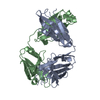 4hk0S S: Starting model for refinement C: citing same article ( |
|---|---|
| Similar structure data |
- Links
Links
- Assembly
Assembly
| Deposited unit | 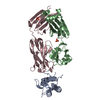
| ||||||||
|---|---|---|---|---|---|---|---|---|---|
| 1 |
| ||||||||
| Unit cell |
| ||||||||
| Components on special symmetry positions |
|
- Components
Components
| #1: Protein | Mass: 16523.906 Da / Num. of mol.: 1 Mutation: Residues 127 to 131 were deleted in the construct used for crystallisation. Source method: isolated from a genetically manipulated source Details: Before crystallisation, the N-terminal His-tag (residues 1 - 17, MGSSHHHHHHSSGLVPR) was removed by thrombin cleavage. Residues 127 to 131 of TSLP (127-RRKRK-131) (according to the reference ...Details: Before crystallisation, the N-terminal His-tag (residues 1 - 17, MGSSHHHHHHSSGLVPR) was removed by thrombin cleavage. Residues 127 to 131 of TSLP (127-RRKRK-131) (according to the reference sequence numbering scheme for TSLP) were deleted in the construct used for crystallization. Source: (gene. exp.)  Homo sapiens (human) / Gene: TSLP / Plasmid: pET15b-hTSLPdelta127-131 Homo sapiens (human) / Gene: TSLP / Plasmid: pET15b-hTSLPdelta127-131 Details (production host): ORF cloned between NdeI and BamHI sites Production host:  | ||||
|---|---|---|---|---|---|
| #2: Antibody | Mass: 25870.895 Da / Num. of mol.: 1 Source method: isolated from a genetically manipulated source Details: The signal peptide (residues 1 - 28) is removed from the mature protein. Source: (gene. exp.)  Homo sapiens (human) / Plasmid: pHLsec Homo sapiens (human) / Plasmid: pHLsec Details (production host): ORF cloned between AgeI and KpnI sites Cell line (production host): HEK-293T / Production host:  Homo sapiens (human) Homo sapiens (human) | ||||
| #3: Antibody | Mass: 28438.221 Da / Num. of mol.: 1 Source method: isolated from a genetically manipulated source Details: The signal peptide (residues 1 - 28) is removed from the mature protein. Source: (gene. exp.)  Homo sapiens (human) / Plasmid: pHLsec Homo sapiens (human) / Plasmid: pHLsec Details (production host): ORF cloned between AgeI and KpnI sites Cell line (production host): HEK-293T / Production host:  Homo sapiens (human) Homo sapiens (human) | ||||
| #4: Chemical | | #5: Water | ChemComp-HOH / | Has protein modification | Y | |
-Experimental details
-Experiment
| Experiment | Method:  X-RAY DIFFRACTION / Number of used crystals: 1 X-RAY DIFFRACTION / Number of used crystals: 1 |
|---|
- Sample preparation
Sample preparation
| Crystal | Density Matthews: 2.26 Å3/Da / Density % sol: 45.49 % |
|---|---|
| Crystal grow | Temperature: 293 K / Method: vapor diffusion, sitting drop / pH: 4.6 Details: 0.2 M ammonium sulfate 0.1 M sodium acetate pH 4.6 25% w/v polyethylene glycol 4000 |
-Data collection
| Diffraction | Mean temperature: 100 K |
|---|---|
| Diffraction source | Source:  SYNCHROTRON / Site: SYNCHROTRON / Site:  SOLEIL SOLEIL  / Beamline: PROXIMA 2 / Wavelength: 0.9801 Å / Beamline: PROXIMA 2 / Wavelength: 0.9801 Å |
| Detector | Type: DECTRIS EIGER X 9M / Detector: PIXEL / Date: Dec 17, 2015 |
| Radiation | Monochromator: Si[111] / Protocol: SINGLE WAVELENGTH / Monochromatic (M) / Laue (L): M / Scattering type: x-ray |
| Radiation wavelength | Wavelength: 0.9801 Å / Relative weight: 1 |
| Reflection | Resolution: 2.298→55 Å / Num. obs: 25284 / % possible obs: 97 % / Redundancy: 8.4 % / Biso Wilson estimate: 47.33 Å2 / CC1/2: 0.998 / Rrim(I) all: 0.11 / Net I/σ(I): 14.23 |
| Reflection shell | Resolution: 2.298→2.44 Å / Redundancy: 4.2 % / Mean I/σ(I) obs: 1.6 / Rrim(I) all: 0.747 / % possible all: 83.8 |
- Processing
Processing
| Software |
| ||||||||||||||||||||||||||||||||||||||||||||||||||||||||||||||||||||||
|---|---|---|---|---|---|---|---|---|---|---|---|---|---|---|---|---|---|---|---|---|---|---|---|---|---|---|---|---|---|---|---|---|---|---|---|---|---|---|---|---|---|---|---|---|---|---|---|---|---|---|---|---|---|---|---|---|---|---|---|---|---|---|---|---|---|---|---|---|---|---|---|
| Refinement | Method to determine structure:  MOLECULAR REPLACEMENT MOLECULAR REPLACEMENTStarting model: 4HK0, chain B; 4HIE, chain B Resolution: 2.298→44.796 Å / SU ML: 0.3 / Cross valid method: FREE R-VALUE / σ(F): 1.39 / Phase error: 23.26 Details: - rigid body refinement (single rigid body per domain) - Iterative cycles of refinement, model (re)building and validation xyz coordinate refinement real-space refinement individual B- ...Details: - rigid body refinement (single rigid body per domain) - Iterative cycles of refinement, model (re)building and validation xyz coordinate refinement real-space refinement individual B-factors riding hydrogens optimisation of X-ray/stereochemistry weight optimisation of X-ray/ADP weight structure validation in COOT, Phenix (Molprobity) and PDB_REDO
| ||||||||||||||||||||||||||||||||||||||||||||||||||||||||||||||||||||||
| Solvent computation | Shrinkage radii: 0.9 Å / VDW probe radii: 1.11 Å | ||||||||||||||||||||||||||||||||||||||||||||||||||||||||||||||||||||||
| Refinement step | Cycle: LAST / Resolution: 2.298→44.796 Å
| ||||||||||||||||||||||||||||||||||||||||||||||||||||||||||||||||||||||
| Refine LS restraints |
| ||||||||||||||||||||||||||||||||||||||||||||||||||||||||||||||||||||||
| LS refinement shell |
|
 Movie
Movie Controller
Controller


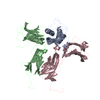
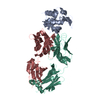
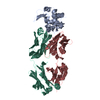

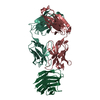
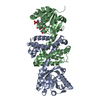

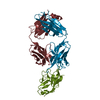


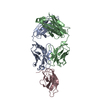
 PDBj
PDBj




